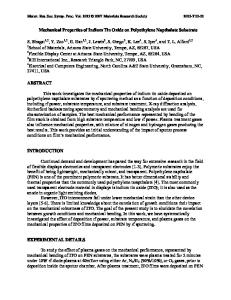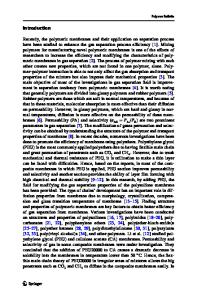Inclusion of graphene on low-density polyethylene composite properties
- PDF / 1,252,118 Bytes
- 11 Pages / 595.276 x 790.866 pts Page_size
- 93 Downloads / 325 Views
RESEARCH ARTICLE
Inclusion of graphene on low‑density polyethylene composite properties Maziyar Sabet1 · Hassan Soleimani2 Received: 10 October 2018 / Accepted: 2 December 2019 © Central Institute of Plastics Engineering & Technology 2019
Abstract The logical outline and assembly of structural–functional materials are a progressive tendency of materials knowledge. Graphene (Gr) spread in LDPE considerably increases thermal/mechanical properties of LDPE/Gr composites. DMA and strength testing machine were used to study mechanical properties. The high specific surface areas and superior properties of Gr improved thermal strength, conductivity, storage modulus, and mechanical properties of composites. The electrical conductivity upgraded owing to the great thermal strength of Grs in LDPE matrix. In terms of rheology, the addition of Grs augmented viscosity of LDPE matrix. Outstanding distribution of Grs was accomplished. LDPE/Gr composites were characterized by SEM, TEM, Raman spectra, XRD, TGA and DSC to study distribution morphology and thermal strength. Results display that presence of filler does not create an alteration in microscopic structure of polymers. However, on a macroscopic scale, Gr constrains mobility of polymer chains, causing a growth in stiffness and strength of composite. Keywords Graphene · Low-density polyethylene · Characterization · Composites
Introduction Contemporary advances in nanotechnology have directed to renewed attention in a specific class of materials known as polymer composites, in which nanoscale filler materials are introduced to a polymeric matrix with the aim of improving mechanical and physical properties [1–5]. Nanofiller is one of the significant additives to advance polymer properties and composites which are normally weightless with superior mechanical and definite practical properties [6–11]. High level of aspect ratio for nanofillers generates extra interaction among polymeric chain and nanofillers which forms complex interfacial morphology when compared with pure polymers [12–18]. The genuine functioning of Gr is deterred by aggregation resulting from its high aspect ratio and strong van der Waals attraction forces between Gr sheets [19–25]. * Maziyar Sabet [email protected] 1
Thus, aggregation makes restricted access deterring broad function of Gr [26–32]. Although for rendering and using these huge surface areas of Grs, Grs should be distributed in polymers, or else, Grs aggregate and the huge surface areas will not be easily reached. Some experiments have verified that when one of the dimensions of filler is in the range of 10–9 m, polymer-based composite displays exclusive physical, chemical and mechanical properties, matched with composites strengthened with a similar quantity of microparticles [33–49]. The differences between regular reinforcement and nanoscale fillers are distinguished by a reduction in the dimensions of nanoparticles which expand surface areas in contact with the polymer matrix which is called ‘nano-effects’ in composite configurations
Data Loading...











